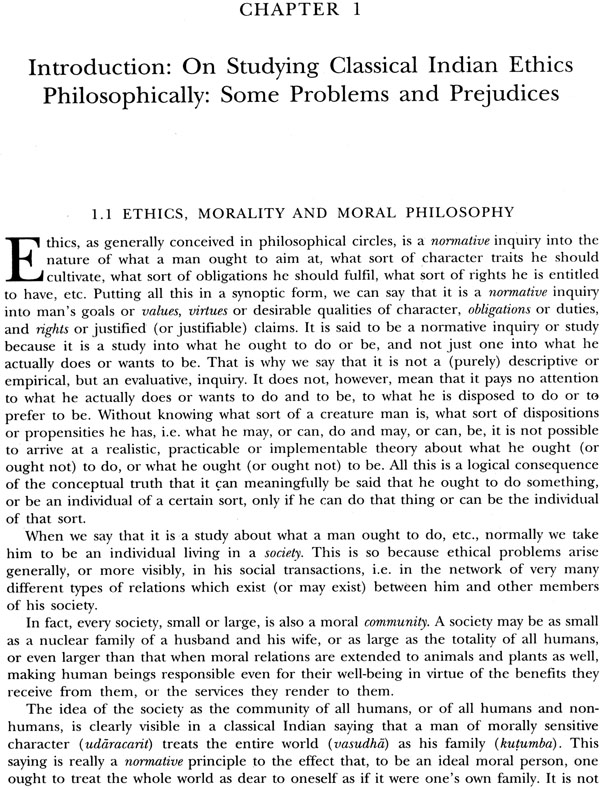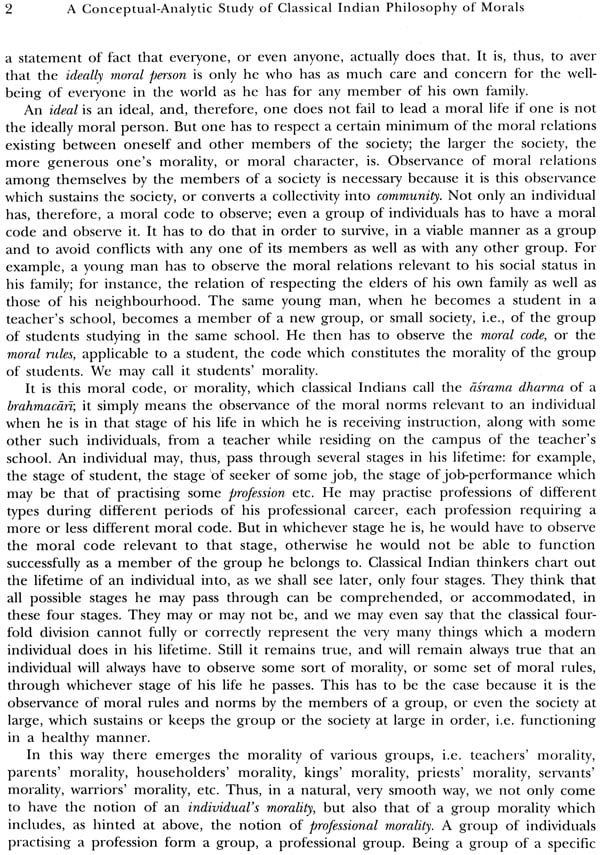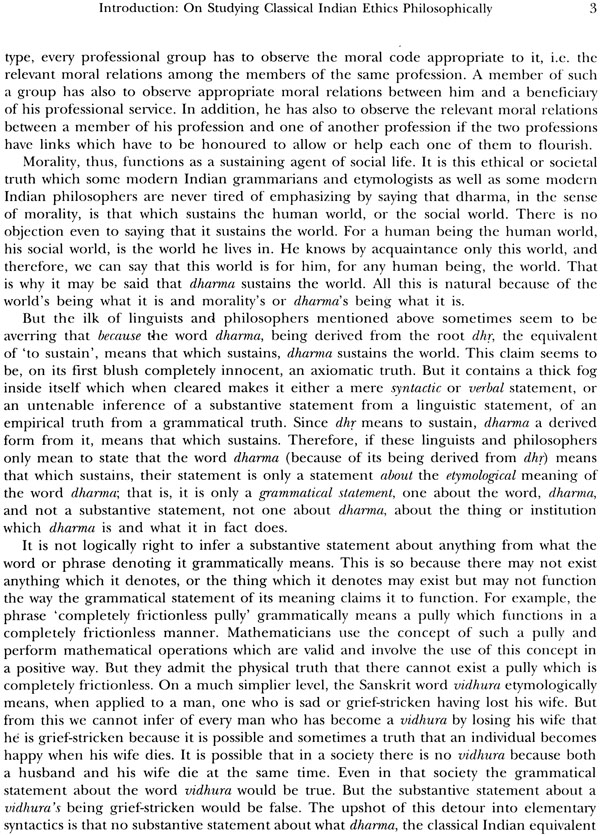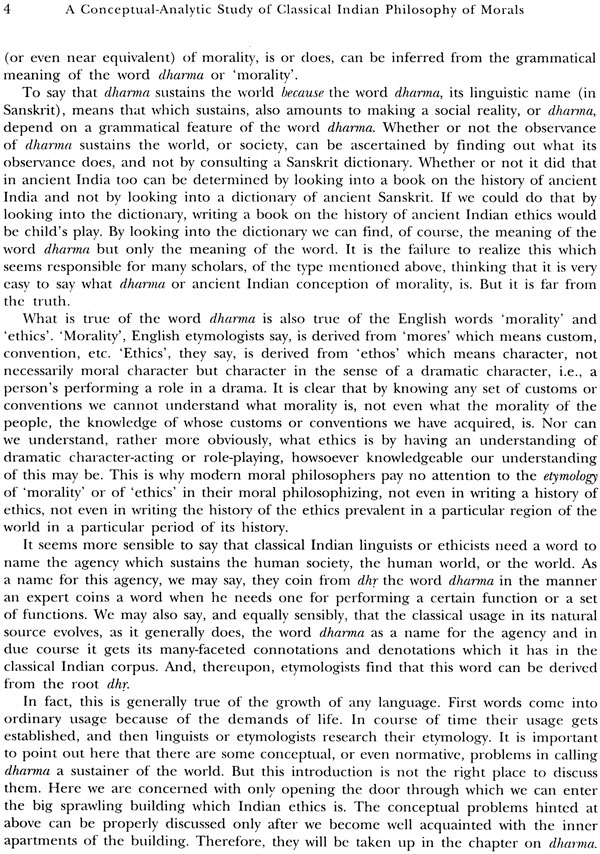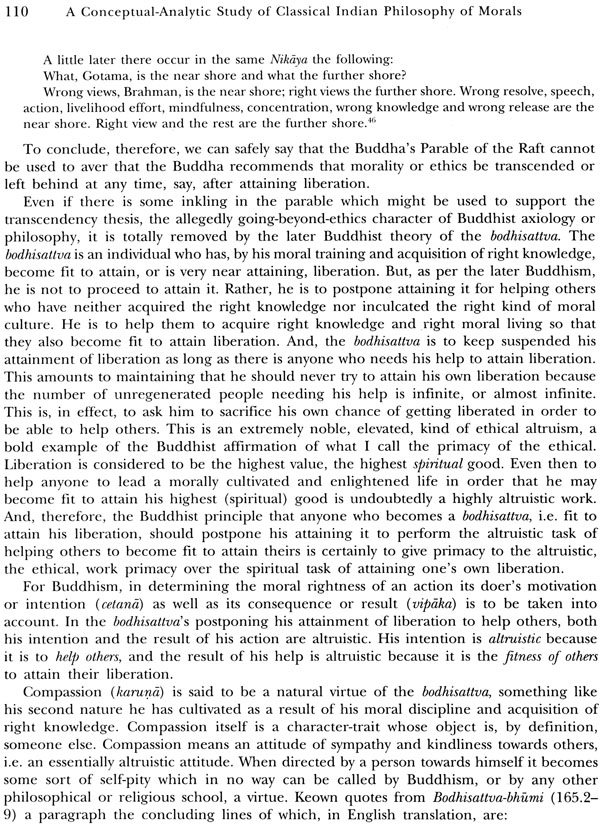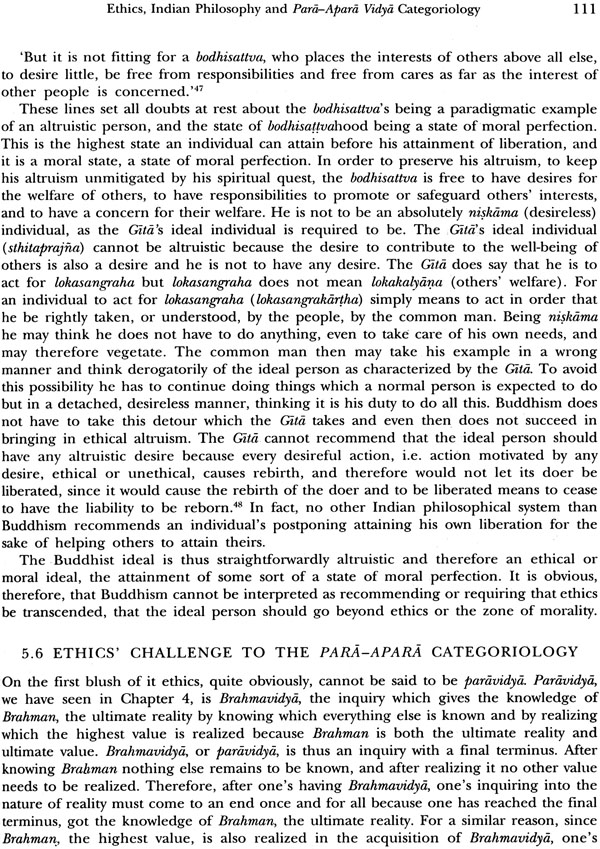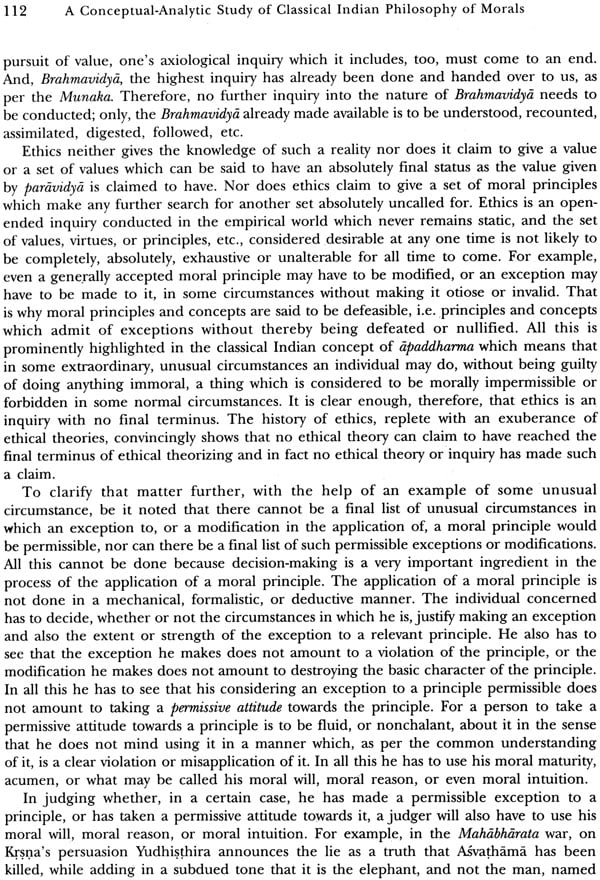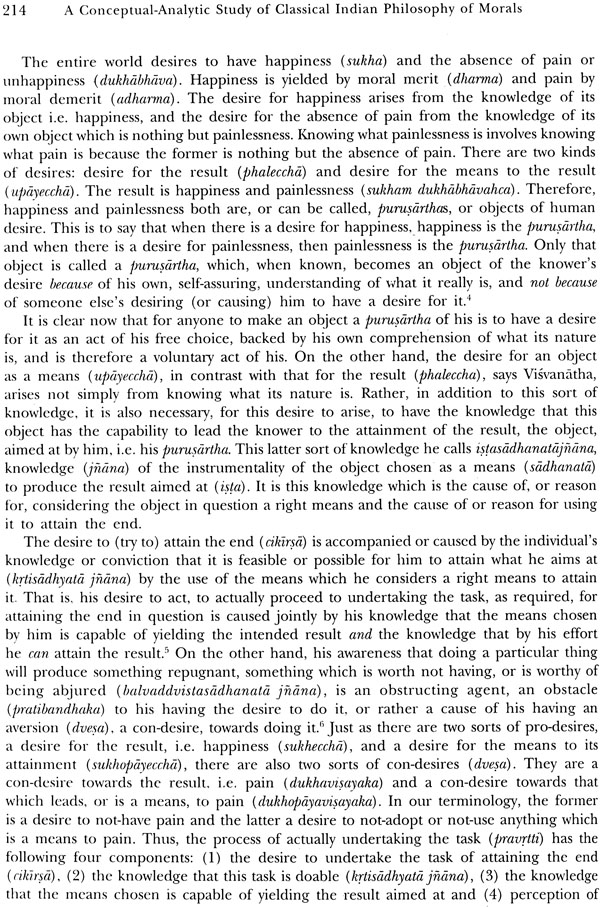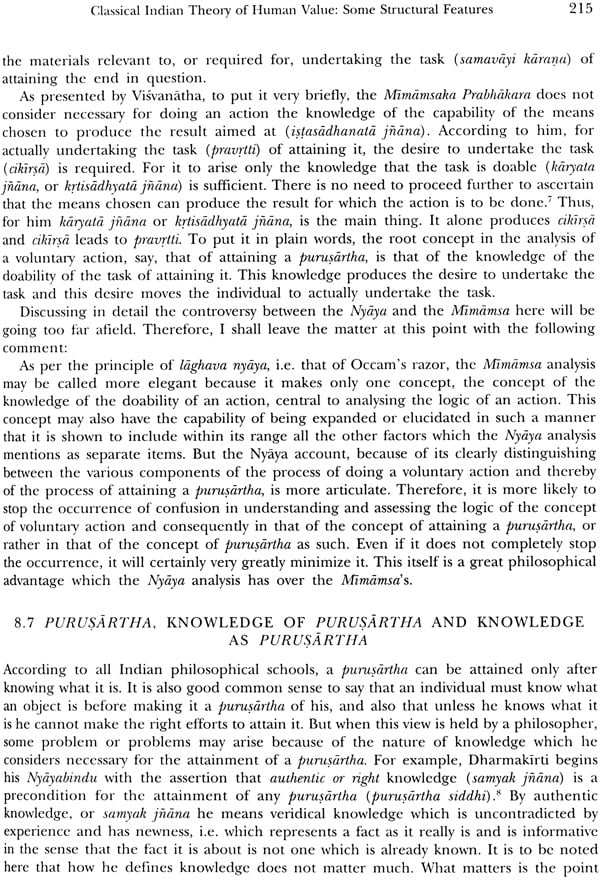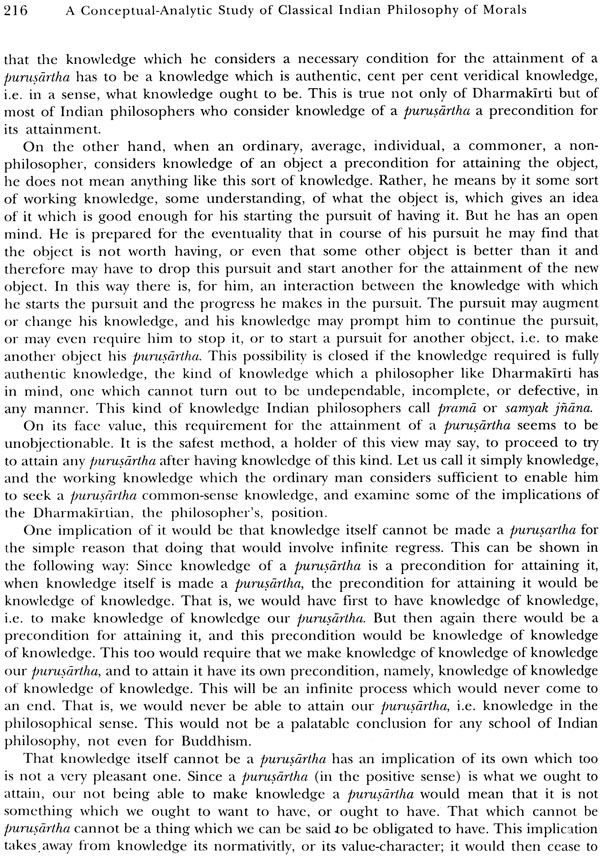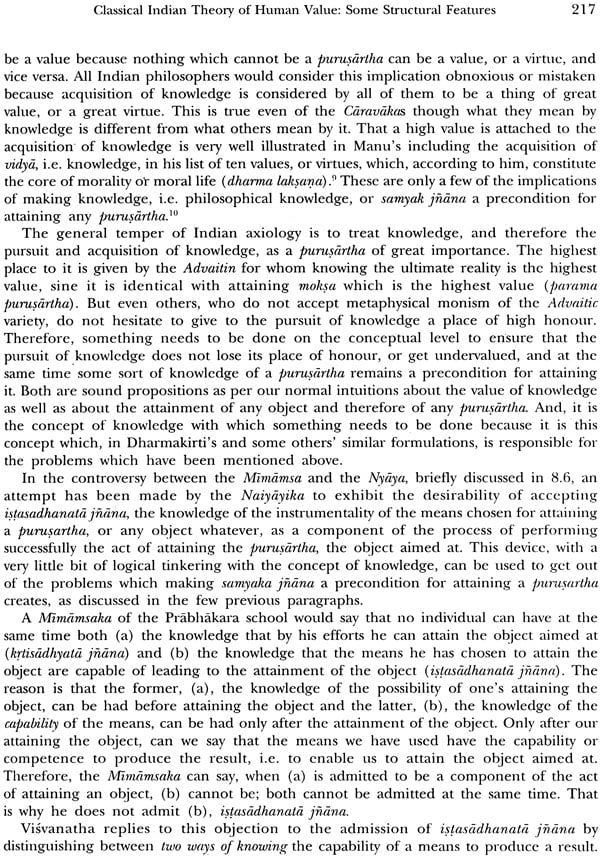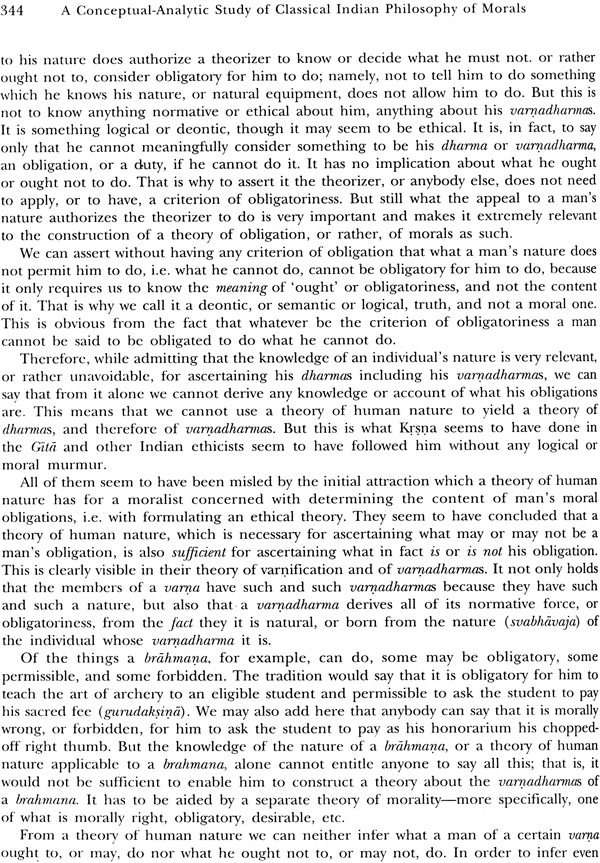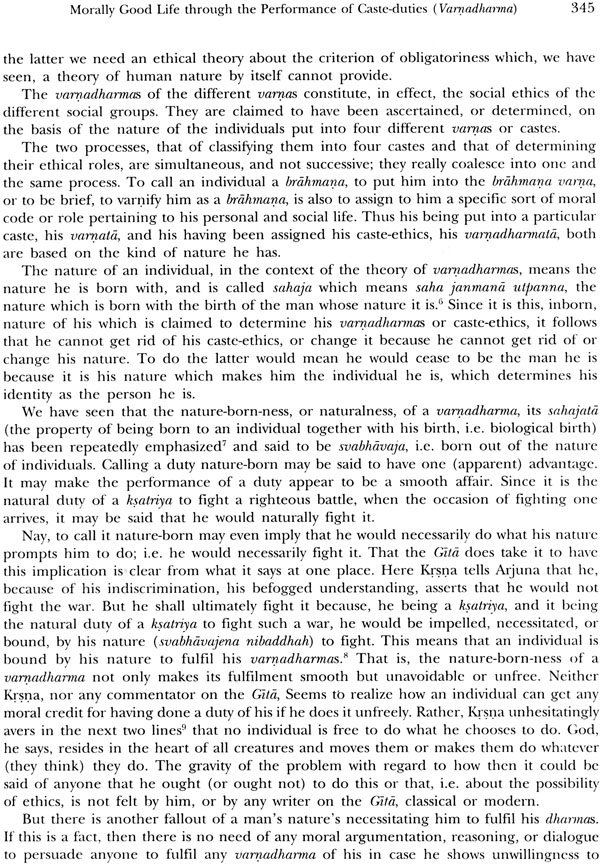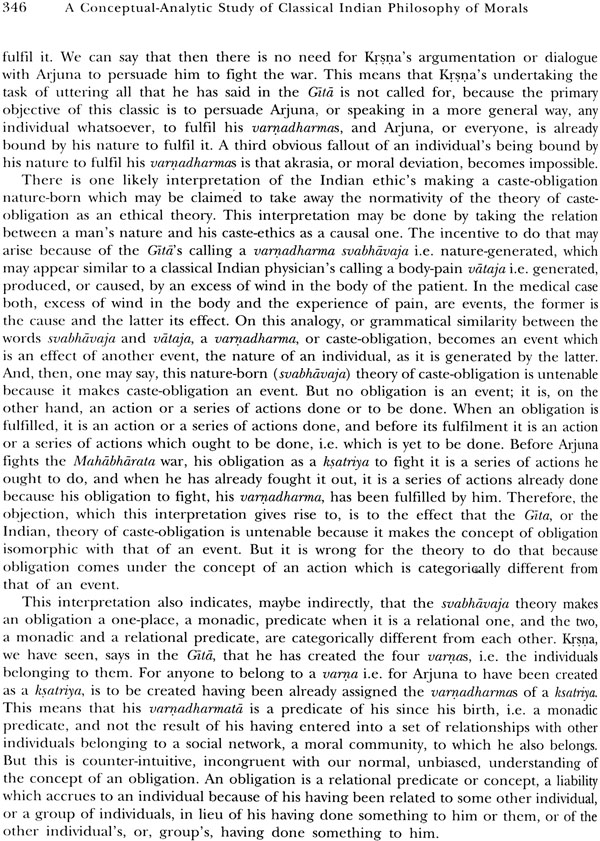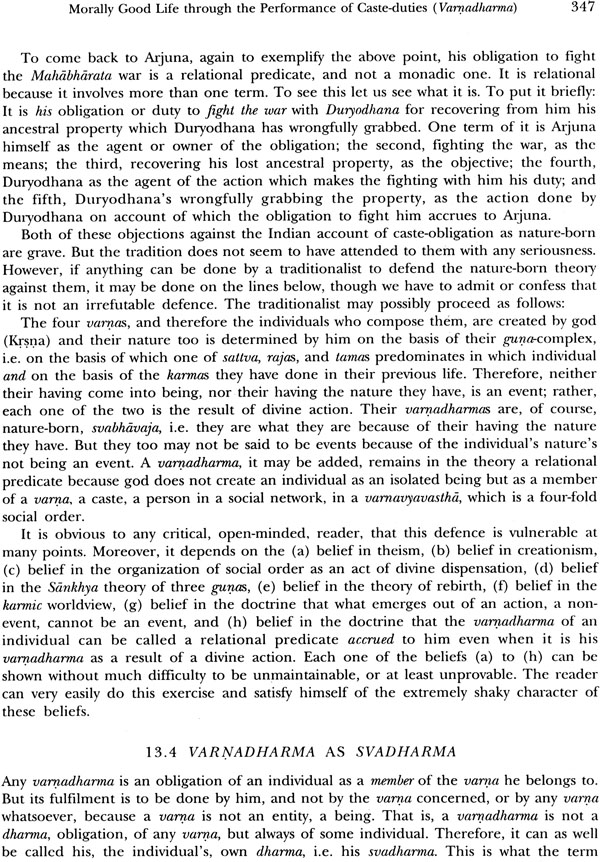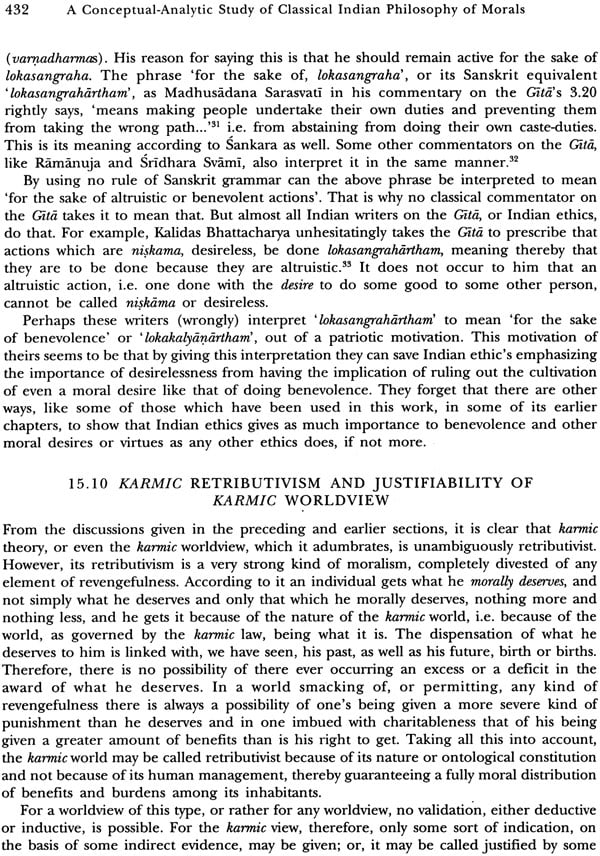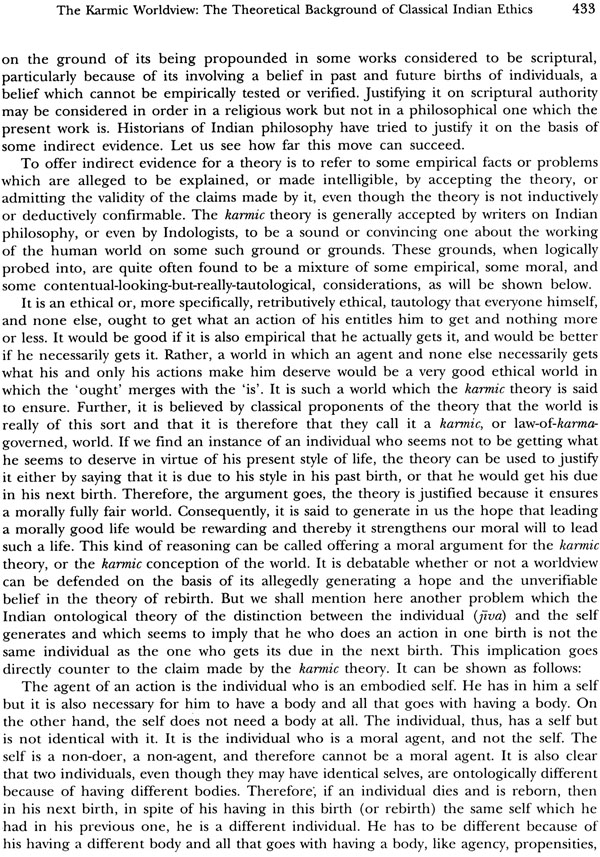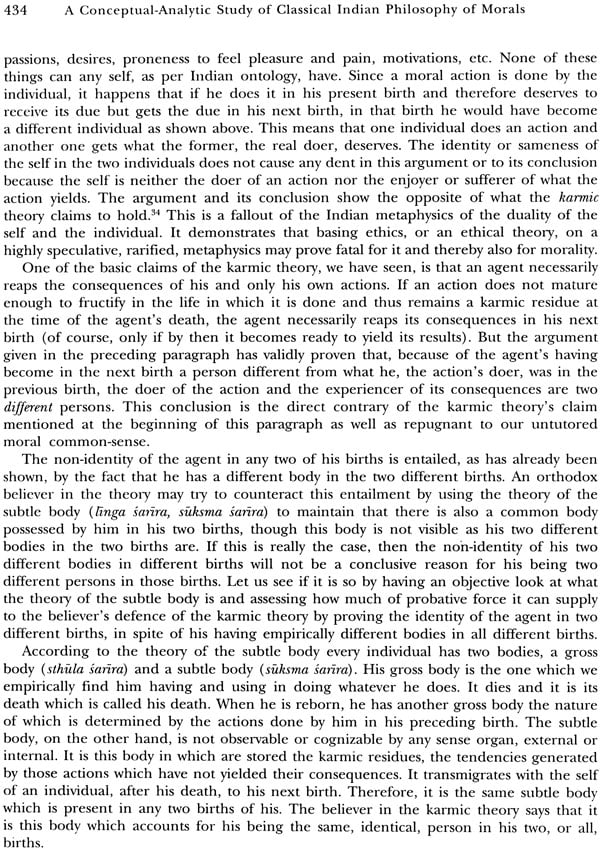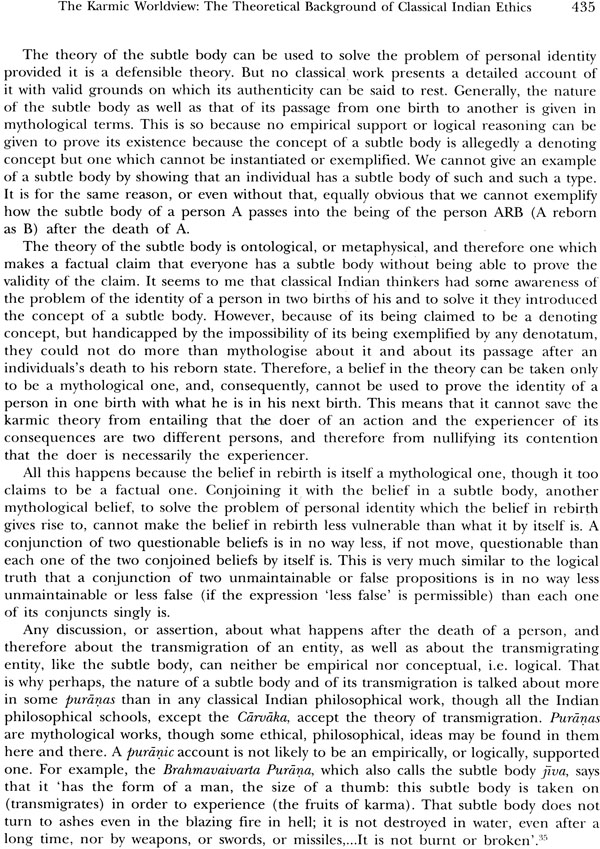
A Conceptual-Analytic Study of Classical Indian Philosophy of Morals
Book Specification
| Item Code: | NAD619 |
| Author: | Rajendra Prasad |
| Publisher: | Centre For Studies in Civilizations |
| Edition: | 2008 |
| ISBN: | 9788180695445 |
| Pages: | 479 |
| Cover: | Hardcover |
| Other Details | 11.5 inch X 8.5 inch |
| Weight | 1.60 kg |
Book Description
The Volume of the Project of History of Science, Philosophy and Culture in Indian Civilization aim to discover the central aspects of India’s heritage and present them in an interrelated manner. In spite of their unitary look, these volumes recognize the difference between the areas of material civilization and those of ideational culture. The Project is not being executed by a single group of thinkers, methodologically uniform or ideologically identical in their commitments. Rather, contributions are made by different scholars of diverse ideological persuasions and methodological approaches. The Project is marked by what may be called ‘methodological pluralism’. In spite of its primarily historical character, this project, both in its conceptualization and execution, has been shaped by scholars drawn from different disciplines. It is the first time that an endeavour of such unique and comprehensive character has been undertaken to study critically a major world civilization.
Using reconstructive ideas available in classical Indian original works, this book makes a departure in the style of modern writings on Indian moral philosophy. It presents Indian ethics, in an objective, secular, and wherever necessary, critical manner as a systematic, down-to-earth, philosophical account of moral values, virtues, rights and obligations. It thereby refutes the claim that Indian philosophy has no ethics as well as the counter-claim that it transcends ethics. It demonstrates that moral living proves that the individual, his society and the world are really real and not only taken to be real for behavioral purposes as the Aviations hold, the self is amoral being a non-agent, moksa is not a moral value, and the Karmic theory, because of involving belief in rebirth, does not guarantee that the doer of an action is also the experience of its results, contrary to what is commonly held, and Indian ethics can sustain itself even if such notions are dropped. Rajendra Prasad calls Indian ethics organisn because, along with ethical concerns, it also covers issues related to professions, politics, administration, sex, environment, etc. Therefore, in one format it is theoretical and applied, normative and met ethical, humanistic and non-humanistic, etc, of course, within the limits of the then cognitive enquiry.
The language of the book is simple and no technical. Its critical and reconstructive temper may provoke a researcher to think afresh on the issues it discusses. But the way it discusses them would make it intelligible and enjoyable even to a non-specialist.
D. P. Chattopadhyaya has studied, researched on law, Philosophy and history, and has taught at various universities in India. Asia, Europe and the USA from 1954 to 1994. Founder-Chairman of the Indian Council of Philosophical Research (1981- 90) and President-cum-Chairman of the Indian Institute of Advanced Study, Shimla (1984-91), Chattopadhyaya is currently the Project Director of the multidisciplinary 96-volume Project of History of Indian Science Philosophy and Culture and Chairman of the Center for Studies in Civilization. He is a Life Member of the Russian Academy of Sciences and a Member of the International Institute of Philosophy, Paris. Among his 35 books, of which he has authored 18 and edited 17, are Individuals and Societies; Individuals and Words; Sri Aurobindo and Karl Marx; Anthropology and Historiography of Science; Induction, Probability and Skepticism; Sociology, Ideology and Utopia; Societies, Cultures and Ideologies, Interdisciplinary studies in Science, Society, Value and Civilization Dialogue and Philosophy of Science, Phonomonology and other essays. Besides, he has held high Public Offices, namely, Union cabinet minister and state governor.
Rajendra Parsad, formerly senior professor of philosophy and head of the department of humanities and social sciences of Indian Institute of Technology (I.I.T.), Kanpur, has studied and researched on modern logic, moral philosophy and analytic philosophy in Indian and U.S. Universities. He has been awarded several fellowships and honours in India and abroad. He has published seven books, the most recent being A Conceptual-Analytic Study of Classical Indian Philosophy of Morals, a predecessor of the present volume, in the same series of Phispc. He has edited another book published by Indian Institute of Advanced Study, Shimla. In addition, he has to his credit more than a hundred research papers published in periodicals in India and abroad.
Yasya nãsti nijã prajna kevalam tu bahugrutah
Na sa janati ãstrãrtham darvi suparsaniva.
‘He, who has no creative intellect of his own, who has only listened to (collected) the views of many others (about them), does not know what those authoritative works really mean, just as a spoon does not know the taste of the soup (it so many times moves in).’
This book is a component of the Project of History of Indian Science, Philosophy and Culture, being the first part of the parent volume Consciousness and Value. The second part, partly written and edited by me, is A Historical-Developmental Study of Indian Philosophy of Morals. In both the parts, the terms ‘philosophy of morals’, ‘ethics’, ‘ethical theory’, ‘moral philosophy’, etc., are used synonymously. ‘Ethics’ is sometimes in philosophical, or social-scientific, literature, also used to denote moral codes, practices, etc., of a people. In this work too sometimes it is used in that sense. But when it is, the context of its use makes it definitively clear that it is so used.
The project, as its name suggests, aims at presenting, through historical studies, India’s contribution to the world. In the case of the achievements of classical India in the realm of value-studies, a strong thought has been lingering, and continues to linger, in my mind, that the career of its general theory of value and, more particularly, of its moral philosophy, is of such a type that neither its conceptual, nor its normative, structure is likely to be made clear by a purely historical study alone. I have always felt that a separate, book-length, systematic and theoretical discussion of it was required to do that and to provide a support to the proposed, or any, historical volume on Indian ethics. Such a work is also needed because almost all existing writings on Indian ethics offer only something like a bag of mixed Ideological and loosely historical, or semi-historical, studies, in a non-conceptual-analytical manner, generally shying away from subjecting any basic view to a philosophical criticism. My feeling has been shared by Professor D.P. Chattopadhyaya. Knowing very well my philosophical leaning, he himself suggested, before I had actually begun working on the Project as an Editorial Fellow, that, whatever else I did, I should write a conceptual-analytic account of the Indian philosophy of morals. His suggestion encouraged me, almost like a trusted friend’s advice to a habitual drinker to drink another bottle of his favorite wine.
I have been studying and writing on some of the basic concepts of classical Indian moral philosophy for the last three or four decades, in a pick-and-choose manner. All along in my journey in this territory I have found that the Indian ethical corpus is like a drum, rich in its musical potentialities, but by itself not producing any sound, let alone a musical sound. To make it yield a musical sound, one has to beat it in a particular style and with sophistication and grace. The philosophical beating of a corpus, ethical or otherwise, can be done only with the tool of logical or conceptual analysis. The philosopher can, then, get out of it the theories or views its progenitors intended it to yield, or even better ones, or even some which are not worth having and therefore are indicative of the fact that the corpus needs to be modified, remodeled, or interpreted in a different manner. Such eventualities are to be welcomed because they contribute to philosophical progress.
The Indian ethical corpus, like any classical one, does not always speak in the same voice, and therefore, it can be taken by different thinkers to mean different things. That is why no claim is made here that the kind of moral philosophy it has been taken to yield is the only one which it can yield. If another writer brings out another kind of yield, let him do that. Such exercises also contribute to progress, of course, provided they are done without any doctrinal or ancestral bias and all the steps which are taken in them to reach their destination are logically sound.
The homeland of Indian ethics is generally taken to be Indian philosophy. This practice is in order, even though ethical ideas are found even in some non-philosophical works, for example, in anecdotes, myths and mythologies, epics, etc. I have taken into account some such works as well but still consider Indian ethics as housed in Indian philosophy. Therefore, I have first characterized, or rethought, the Indian style of philosophizing, ascertained its distinctive status as a cognitive inquiry and then located the place of ethics in it. In course of doing that I have found that Indian philosophy’s admitting the possibility of ethics has entailed that the world and the individual have to be accepted as real because it is the individual who has to lead a moral life and to lead it in the world he lives in, the only world we are acquainted with. I have shown that it is the realization of this fact which has motivated the Advent in Sankara to tone down his abstract metaphysical monism.
All along in this work, as I have done in my others, I have taken all classical writings as human documents, as works written, or words uttered, by human beings. I do not mind calling them rise, saintly knower or seers of truths as the truths appeared to them. But I am against having, what I have called elsewhere, the rib bias, the bias that what (a thinker called) a has said is too sacrosanct to be criticized or critically evaluated. I am also against having any ancestral bias to the effect that our classical corpus, which is our ancestral heritage, is never to be criticized. It is obvious that the two biases would block philosophical or intellectual progress because having them would not let us make new uses of classical ideas, i.e. not allow us to build new conceptual structures on any part of the classical corpus. Resistance to taking such steps springs from the wrong notion that critically evaluating the view of a rim is to show him disrespect and so is to put a classical idea to a new use. This is a retrogressive understanding of a classical achievement.
Classical ideas are our capital. They will survive and grow only by our investing them in new philosophical enterprises and not by our putting them on a pedestal and worshipping them with flowers and sandal-paste and songs in their praise. Therefore, I have criticized classical ethical views if demanded by logic and addressed all classical thinkers, even Rirna, Ki-sna, iva, etc., by their names without prefixing the names with any honorific ‘iiocd, though my respect for them is in no way less than anyone else’s.
Conical evaluation of a theory and exhibiting a possibility of a reconstruction’s removing new weak point in it add to the theory’s survival-value. Therefore, I have done both, wherever necessary, in an objective, open-minded, fashion. I have also tried to present Indian ethics as ethics, as the term ‘ethics’ or its equivalent, ‘moral philosophy’, etc., is .ed in philosophical literature, and neither as ‘Indian’ in a regional sense, nor as an appendix to Indian metaphysics or theology, without denying that it has links with almost fl sectors of Indian philosophy, or philosophy in general.
My appraisal, or even statement, of Indian ethical theory, has been given from the point of view of a man who has to live it, i.e. to live his life in accordance with it, and not from that of one who discusses it only as a piece in the history of classical Indian philosophy, i.e. as a record of how some Indian thinkers ethicized, no matter whether not it has any relevance today. This seems to me the most reasonable way to ascertain the strengths or weaknesses of any ethical theory.
In my characterization of the theory I have depended almost exclusively on original ricers. I have very sparingly referred to modern interpretations. Where I have done so, it is either to show their amenability, or to convince the reader that the way I have understood a certain issue is in no way strange or bizarre because some orthodox scholars also understood it the same way. The motivation for doing the latter is to show that — implications which these understandings of the issue yields, as I have drawn them from it and the orthodox scholars have not are not from my distorted viewpoint, but from a current or prevalent understanding of the issues.
Since the parent volume of the present work is Consciousness and Value, the reader may that this work should also have discussed the classical Indian philosophy of aesthetics. not done that because an independent book on Indian aesthetics is in preparation the Project as a separate venture.
When I started writing this book, I did not expect it to be of its present size, and to as much time as it has done, nor did I expect it to be in any way arduous. But my expectations were belied as soon as I began doing the drill. And, it became so engrossing add use-consuming that I could not check what I have said in it with what I have written me related themes in my other works. But in spite of all this I have enjoyed working - the book largely because of the constant encouragement, sympathy and appreciation I bee received from Professor D.P. Chattopadhyaya, the Chairman of the Project and of Centre for Studies in Civilizations. He is one of the rare and fast vanishing class of people who do not believe that he who pays the piper must call the tune. I am greatly bitted to him for having given to me an unfettered right to write the book even in a wrong’ way if my logic convinces me that that is the right way.
I am also very thankful to Professor Bhuvan Chandel, Project Coordinator of the project and the Centre, for giving me whatever help I needed from her and her office.
The second half of Chapter 13 and the major portion of Chapter 14 were written at spur at my eldest son-in-law, Dr Ajay K. Srivastava’s residence when my wife was degrading radiation therapy in a hospital there. Ajay and my daughter Asha provided with all the facilities and emotional support in what was a difficult time for all of us the family, which enabled me to continue my writing work even under those circumstances. The support I have received from my wife, even when she was ill, and from all my children and grandchildren is exemplary. My blessings to all of them.
The book has been written with an international readership in mind. Care has been taken to make its language, as far as practicable, non-technical, or the least technical, so that even he who has no training in moral philosophy or philosophy, Indian or Western, may not find it unintelligible. Its chapters are interconnected, but a reader can read selectively some chapter or chapters without any undue strain on his understanding. Whenever a Sanskrit word occurs, generally its English equivalent has been given. If that has not been done in some cases, the context of its use has been made clear so that a reader who ignores the Sanskrit word would have no difficulty in understanding what is said therein. However, how successful I have been in achieving all this can be judged only by the discriminating reader.
It is understandable that man, shaped by Nature, would like to know Nature. The human of knowing Nature are evidently diverse, theoretical and practical, scientific and logical, artistic arid spiritual. This diversity has, on scrutiny, been found to be let exhaustive nor exclusive. The complexity of physical nature, life-world and, particularly, human mind is so enormous that it is futile to follow a single method for comprehending all the aspects of the world in which we are situated.
One need not feel bewildered by the variety and complexity of the worldly phenomena. After all, both from traditional wisdom and our daily experience, we know that our own nature is not quite alien to the structure of the world. Positively speaking, the elements and forces that are out there in the world are also present in our body-mind complex, enabling us to adjust ourselves to our environment. Not only the natural conditions but also the social conditions of life have instructive similarities between them. This is not to underrate in any way the difference between the human ways of life all over the world. It is partly due to the variation in climatic conditions and partly due to the distinctness of production-related tradition, history and culture.
Three broad approaches are discernible in the works on historiography of civilization, comprising science and technology, art and architecture, social sciences and institutions. Firstly, some writers are primarily interested in discovering the general laws which govern i1 civilizations spread over different continents. They tend to underplay what they call the noisy local events of the external world and peculiarities of different languages, literatures and histories. Their accent is on the unity of Nature, the unity of science and the unity of mankind. The second groups of writers, unlike the generalist or transcendentalist ones, attach primary importance to the distinctiveness of every culture. To these writers, human freedom and creativity are extremely important and basic in character. Social institutions and the cultural articulations of human consciousness, they argue, are bound to be expressive of the concerned people’s consciousness. By implication they tend to reject concepts like archetypal consciousness, universal mind and providential history. There is a third group of writers who offer a composite picture of civilizations, drawing elements both from their local and common characteristics. Every culture has its local roots and peculiarities. At the same time, it is pointed out that due to demographic migration and immigration over the centuries an element of compositeness emerges almost in every culture. When, due to a natural calamity or political exigencies people move from one part of the world to another, they carry with them, among other things, their language, cultural inheritance and their ways of living.
In the light of the above facts, it is not at all surprising that comparative anthropologists and philologists are intrigued by the striking similarity between different language families and the rites, rituals and myths of different peoples. Speculative philosophers of history, heavily relying on the findings of epigraphy, ethnography, archaeology and theology, try to show in very general terms that the particulars and universals of culture are ‘essentially’ or ‘secretly’ interrelated. The spiritual aspects of culture like dance and music, beliefs pertaining to life, death and duties, on analysis, are found to be mediated by the material forms of life like weather forecasting, food production, urbanization and invention of script. The transition from the oral culture to the written one was made possible because of the mastery of symbols and rules of measurement. Speech precedes grammar, poetry prosody. All these show how the ‘matters’ and ‘forms’ of life are so subtly interwoven.
The PHISPC publications on History of Science, Philosophy and Culture in Indian Civilization, in spite of their unitary look, do recognize the differences between the areas of material civilization and those of ideational culture. It is not a work of a single author. Nor is it being executed by a group of thinkers and writers who are methodologically uniform or ideologically identical in their commitments. In conceiving the Project we have interacted with, and been influenced by, the writings and views of many Indian and non-Indian thinkers.
The attempted unity of this Project lies in its aim and inspiration. We have in India many scholarly works written by Indians on different aspects of our civilization and culture. Right from the pre-Christian era to our own time, India has drawn the attention of various countries of Asia, Europe and Africa. Some of these writings are objective and informative and many others are based on insufficient information and hearsay, and therefore not quite reliable, but they have their own value. Quality and viewpoints keep on changing not only because of the adequacy and inadequacy of evidence but also, and perhaps more so, because of the bias and prejudice, religious and political conviction, of the writers.
Besides, it is to be remembered that history, like Nature, is not an open book to be read alike by all. The past is mainly enclosed and only partially disclosed. History is, therefore, partly objective or ‘real’ and largely a matter of construction. This is one of the reasons why some historians themselves think that it is a form of literature or art. However, it does not mean that historical construction is ‘anarchic’ and arbitrary. Certainly, imagination plays an important role in it.
But its character is basically dependent upon the questions which the historian raises and wants to understand or answer in terms of the ideas and actions of human beings in the past ages. In a way, history, somewhat like the natural sciences, is engaged in answering questions and in exploring relationships of cause and effect between events and developments across time. While in the natural sciences, the scientist poses questions about nature in the form of hypotheses, expecting to elicit authoritative answers to such questions, the historian studies the past, partly for the sake of understanding it for its own sake and partly also for the light which the past throws upon the present, and the possibilities which it opens up for mounding the future. But the difference between the two approaches must not be lost sight of. The scientist is primarily interested in discovering laws and framing theories, in terms of which, different events and processes can be connected and anticipated. His interest in the conditions or circumstances attending the concerned events is secondary. Therefore, scientific laws turn out to be basically abstract and easily expressible in terms of mathematical language. In contrast, the historian’s main interest centers round the specific events, human ideas and actions, not general laws. So, the historian, unlike the scientist, is obliged to pay primary attention to the circumstances of the events he wants to study. Consequently, history, like most other humanistic disciplines, is concrete and particularistic. This is not to deny the obvious truth that historical event and processes consisting of human ideas and actions show some trend or other and weave some pattern or other. If these trends and patterns were not there at all in history, the study of history as a branch of knowledge would not have been profitable or instructive. But one must recognize that historical trends and patterns, unlike scientific laws and theories, are not general or purported to be universal in their scope.
The aim of this Project is to discover the main aspects of Indian culture and present them in an interrelated way. Since our culture has influenced, and has been influenced by, the neighboring cultures of West Asia, Central Asia, East Asia and Southeast Asia, attempts have been made here to trace and study these influences in their mutuality. It is well known that during the last three centuries, European presence in India, both political and cultural, has been very widespread. In many volumes of the Project considerable attention has been paid to Europe and through Europe to other parts of the world. For the purpose of a comprehensive cultural study of India, the existing political boundaries of the South Asia of today are more of a hindrance than help. Cultures, like languages, often transcend the bounds of changing political territories.
If the inconstant political geography is not a reliable help to the understanding of the layered structure and spread of culture, a somewhat comparable problem is encountered in the area of historical per iodization. Per iodization or segmenting time is a very tricky affair. When exactly one period ends and another begins is not precisely ascertainable. The periods of history designated as ancient, medieval and modern are purely conventional and merely heuristic in character. The varying scopes of history, local, national and continental or universal, somewhat like the periods of history, are unavoidably fuzzy and shifting. Amidst all these difficulties, the volume-wise details have been planned and worked out by the editors in consultation with the Project Director and the General Editor. I believe that the editors of different volumes have also profited from the reactions and suggestions of the contributors of individual chapters in planning the volumes.
Another aspect of Indian history which the volume-editors and contributors of the Project have carefully dealt with is the distinction and relation between civilization and culture. The material conditions which substantially shaped Indian civilization have been discussed in detail. From agriculture and industry to metallurgy and technology, from physics and chemical practices to the life sciences and different systems of medicines—all the branches of knowledge and skill which directly affect human life—form the heart of this Project. Since the periods covered by the PHISPC are extensive—prehistory,proto-history, early history, medieval history and modern history of India—we do not claim to have gone into all the relevant material conditions of human life. We had to be selective. Therefore, one should not be surprised if one finds that only some material aspects of Indian civilization have received our pointed attention, while the rest have been dealt with in principle or only alluded to.
One of the main aims of the Project has been to spell out the first principles of the philosophy of different schools, both pro-Vedic and anti-Vedic. The basic ideas of Buddhism, Jainism and Islam have been given their due importance. The special position accorded to philosophy is to be understood partly in terms of its proclaimed unifying character and partly to be explained in terms of the fact that different philosophical systems represent alternative world-views, cultural perspectives, their conflict and mutual assimilation.
Most of the volume-editors and at their instance the concerned contributors have followed a middle path between the extremes of narratives and theoretic. The underlying idea has been this: If in the process of working out a comprehensive Project like this every contributor attempts to narrate all those interesting things that he has in the back of his mind, the enterprise is likely to prove unmanageable. If, on the other hand, particular details are consciously forced into a fixed mould or pre-supposed theoretical structure, the details lose their particularity and interesting character. Therefore, depending on the nature of the problem of discourse, most of the writers have tried to reconcile in their presentation, the specificity of narratives and the generality of theoretical orientation. This is a conscious editorial decision. Because, in the absence of a theory, however inarticulate it may be, the factual details tend to fall apart. Spiritual network or theoretical orientation makes historical details not only meaningful but also interesting and enjoyable.
Another editorial decision which deserves spelling out is the necessity or avoid ability of duplication of the same theme in different volumes or even in the same volume.
Certainly, this Project is not an assortment of several volumes. Nor is any volume intended to be a miscellany. This Project has been designed with a definite end in view and has a structure of its own. The character of the structure has admittedly been influenced by the variety of the themes accommodated within it. Again it must be understood that the complexity of structure is rooted in the aimed integrality of the Project itself.
| Preface. | xiii | |
| General Editor and Author | xvii | |
| General Introduction | xix | |
| 1 | Introduction: On Studying Classical Indian Ethics Philosophically: Some Problems and Prejudices | 1 |
| 1.1 | Ethics, Morality and Moral Philosophy | 1 |
| 1.2 | Ethics as Mtiãstra in Indian Nomenclature | 6 |
| 1.3 | Problems and Prejudices | 8 |
| 1.4 | A Way Out | 12 |
| Notes and References | 16 | |
| 2 | Two Concepts of Cognitive Inquiry | 17 |
| 2.1 | Two Ways of Conceiving the Motivation of Inquiry | 17 |
| 2.2 | Two Ways of Conceiving the End of Inquiry | 20 |
| 2.2.1 | No-terminus View of Inquiry | 21 |
| 2.2.2 | Final-terminus View of Inquiry | 22 |
| Notes and References | 23 | |
| 3 | Philosophizing the Classical Indian Way: A Rethinking | 25 |
| 3.1 | Talking about and Doing Philosophy | 25 |
| 3.2 | Received Interpretation of the Classical Indian Way | 27 |
| 3.3 | Classical Indian Philosophy as Darthna: An Inaccurate Characterization | 27 |
| 3.3.1 | Multiple Motivation behind the Characterization | 29 |
| 3.3.2 | Darana not Necessarily Identical with Realization | 30 |
| 3.4 | Classical Indian Philosophy as Essentially Religious: An Unfair Fallout of 2.2 | 32 |
| 3.4.1 | Roots of the Fallout | 35 |
| 3.5 | Reasons Favouring Non-Theological Characterization of Indian Metaphysics | 39 |
| Notes and References | 41 | |
| 4 | Parã and Apara Vidyã: Superiority of Inquiry as Realizing Highest Value over Other Inquiries | 43 |
| 4.1 | Parä and Apara Vidyã: Contextual Setting of the Distinction | 43 |
| 4.2 | Parã and Apara Vidyã: The Distinction Characterized | 47 |
| 4.3 | Parãvidyã as an Inquiry with a Final Terminus | 53 |
| 4.4 | Some Theoretical Consequences of Parãvidyã as the End of Inquiry | 57 |
| 4.5 | Philosophical Progress | 59 |
| 4. 6 | Rethinking the Concept of Parãvidyã in the Context of Philosophical Progress | 61 |
| 4.7 | Para-Apara and Philosophy-Science Distinction | 66 |
| 4. 8 | The Concept of Intuition: A Terminological Clarification | 70 |
| 4.9 | A Concluding Disclaimer | 71 |
| Notes and References | 72 | |
| 5 | Ethics, Indian Philosophy and Para-Apard Vidyd Categoriology | 73 |
| 5.1 | A Congenital Problem | 73 |
| 5.2 | A Methodological Mist | 76 |
| 5.3 | Indian Philosophy as Lacking Ethics | 79 |
| 5.4 | Indian Philosophy as Going Beyond Ethics | 84 |
| 5.5 | The Buddhist Parable of the Raft: Only a Seeming Affirmation of 5.4 | 107 |
| 5. 6 | Ethics’ Challenge to the Pard-Apara Categoriology | 111 |
| Notes and References | 117 | |
| 6 | Theorizing in Ethics: The Indian Way | 119 |
| 6.1 | Reality of the World: A Natural Presupposition of the Possibility of Ethical Life | 119 |
| 6.2 | The Moral Agent: The Individual (Jiva) and Not the Self (Atman) | 124 |
| 6.3 | The Ontological Model Ascribing to the World Reality Only for Practical Purposes (Vyãvahdrika Sattã): Its Adequacy for Satisfying the Possibility Condition of Ethical life Examined | 127 |
| 6.4 | Human-Centricity of Indian Ethics As of Any Ethical Inquiry | 139 |
| 6.5 | Organismic Character of Indian Ethics: Applied and Theoretical Ethics Interacting with Each Other | 147 |
| 6. 6 | Non-rigidity of the Distinction between Applied and Theoretical Ethics | 149 |
| 6.7 | Some. Indian Specimens of Ethical Theorizing the Piecemeal Way: Contentual and Contextual | 156 |
| 6.7.1 | Akrasia | 159 |
| 6.7.2 | Obligation and Stringency | 165 |
| 6. 8 | Why he Moral? | 169 |
| Notes and References | 170 | |
| 7 | Ethics and Social Organization | 173 |
| 7.1 | Ethical life as Social Life: The Classical Indian Version | 173 |
| 7.21 | The Four-fold Social System (Varnãframa Vyavasthã) and Indian Ethics | 176 |
| 7.3 | Vara-system (Vari.’iavyavasthã): The Ability Account | 178 |
| 7.3.1 | The example of Janaruti | 184 |
| 7.3.2 | The example of Satyakdma Jãbala | 188 |
| 7.4 | Untenability of Using Etymology to Defend Ability Account | 196 |
| 7.5 | Mythology and Vara-System | 198 |
| 7. 6 | Exploiting a Hint from Mythology | 199 |
| 7.7 | Mrama-system and Moral Discipline | 200 |
| Notes and References | 204 | |
| 8 | Classical Indian Theory of Human Value: Some Structural Features | 205 |
| 8. 1 | Human Life as Purposive: Desiring as Valuing | 205 |
| 8.2 | The Concept of Purucãrtha and Sources of Its Normativity | 206 |
| 8.3 | The Theory of Purucãrthas: A General Theory of Value without Any Built-in Gender Bias | 208 |
| 8.4 | Positive Purusãrthas, Negative Purusãrthas, and Non-Purusãrthas | 210 |
| 8.5 | Seeking a Purucãrtha: a Voluntary Operation | 211 |
| 8. 6 | The Nyaya Elaboration of Role of Desire in Seeking a Purucãrtha | 213 |
| 8.7 | Purusdrtha, Knowledge of Purusãrtha and Knowledge as Puruãrtha | 215 |
| 8.8 | Open Texture of the Four-fold Typology of Purucãrthas | 218 |
| Notes and References | 227 | |
| 9 | Value as Material Well-being (Artha Purusdrtha) | 229 |
| 9.1 | Action Theory and Value Theory: Explaining and Justifring Pursuit of Material Goods (Artha) | 229 |
| 9.2 | Content of the Artha Category | 232 |
| 9.3 | Artha as a Necessary Condition for Käma and Dharma without Lowering Their Value-Status (Purusãrthatva) | 240 |
| 9.4 | Artha, Dharina and Rdjadharma (Political Ethics) | 243 |
| Notes and References | 245 | |
| 10 | Value as Appetitive Well-being (Kdma Purusdrtha) | 249 |
| 10.1 | Kãrna as Appetition (Kãmanã) | 249 |
| 10.2 | Kãma as All-comprehensive Well-being | 252 |
| 10.3 | Kãrna, Sexual Pleasure, and Gender Ethics | 254 |
| 10.4 | Appetitive Well-being and Moral Regulation (Kãma and Dharma) | 266 |
| Notes and References | 269 | |
| 11 | Value as Living a Morally Good Life (Dharnza Puruãrtha) | 271 |
| 11.1 | Morality as the Core of Dharma in Its Multifarious Meanings | 271 |
| 11.2 | Dharma as the Sustainer of the Human World: Irrelevance of Etymological Analysis | 273 |
| 11.3 | Content of the Concept of Dharma (Morality): Well-being of All | 277 |
| 11.4 | Overemphasis on the Subtlety of the Concept of Dharma: Analysis and Adverse Implication | 282 |
| 11.5 | Ignorance of Fact and Moral Responsibility | 288 |
| 11.6 | Sources of Moral Knowledge: Their Epistemic Competence Examined | 292 |
| Notes and References | 299 | |
| 12 | Morally Good Life through Inculcation of Virtue (Sdinãnya Dharma) | 301 |
| 12.1 | Virtue as Character-trait: A Coherentist Approach | 301 |
| 12.2 | Some Specimens of Virtues (Sdmdnya Dharmas): Compassion (Karuiã) | 305 |
| 12.3 | Forgiveness (Kamã) | 311 |
| 12.4 | Conditional or Unconditional Value of Forgiveness and Some Other Virtues | 317 |
| 12.5 | Concept of Anger: Anger’s Immoral and Moral Potentialities | 319 |
| 12.6 | Indian Ethical Practice not an Echo of Indian Ethical Theory’s General Condemnation of Anger | 322 |
| 12.7 | Return to Forgiveness’s Claim to Being an Unconditional Virtue | 325 |
| 12.8 | Built-in Flexibility of a General Virtue Illustrated | 328 |
| 12.9 | Flexibility of a General Virtue and Ethical Behaviour in Adverse Conditions (Apadharina) | 331 |
| Notes and References | 334 | |
| 13 | Morally Good Life through the Performance of Caste-duties (Varnadharma) | 335 |
| 13.1 | Varna and Varnadharma | 335 |
| 13.1 | Human Nature and Varnadharma | 340 |
| 13.2 | The Indian Ethicist’s Deriving His Ethical Theory of Caste-obligations for His Theory of Human Nature: A Move Apparently Attractive but Conceptually Untenable | 341 |
| 13.4 | Varnadharma as Svadharma | 347 |
| 13.5 | Caste-Ethics and General Ethics (Varitadharma and Sä’inãnya Dharma): The Issue of Priority | |
| 13.6 | Morally Good Life as Not the Completely Good Life: | |
| A Hint from the Inadequacy of the Variadharma Theory | 355 | |
| Notes and References | 357 | |
| 14 | The Highest Purusãrtha: Liberation (Moksa) | 359 |
| 14.1 | Fulfilment of the Person: the End-point of Pursuit of Values | 359 |
| 14.2 | The Concept of Liberation of All (Saruamukti) | 364 |
| 14.3 | Some General Features of Liberation (Moksa) Basic to Understanding Its Place as a Moral Value in Indian Ethics | 366 |
| 14.4 | Termination of Liability to Be Reborn as a Necessary Feature of Liberation (Moksa): Problem of Instantiation | 374 |
| 14.5 | Dreamless sleep (Sucupti) as Giving a Short Glimpse of the State of Liberation (Moksa) | 378 |
| 14.6 | Liberation (Moksa) and Morality: A Procedural Clarification | 387 |
| 14.7 | Morality as a Means to Mokca: An Unworkable Position | 388 |
| 14.8 | Morality as Externally Related Means to Liberation (Mokyz): Making Morality Dispensable for the Liberated | 391 |
| 14.9 | Morality as Internally Related Means to Liberation (Moka): Becoming a Precondition Integrated into Liberation | 394 |
| 14.10 | Liberation (Moksa) and Desire for Liberation (Mumuksã) | 399 |
| Notes and References | 404 | |
| 15 | The Karmic Woridview: The Theoretical Background of Classical Indian Ethics | 405 |
| 15.1 | The World as an Orderly Whole: The Concept of Rta | 405 |
| 15.2 | Classification of Human Actions | 407 |
| 15.3 | The Law of Karma: Statement of Autonomy | 411 |
| 15.4 | The Law of Karma: Elaboration and Evaluation | 412 |
| 15.5 | Logical Consequence of Merging What Ought to Be with What Is in an Effort to Improve What Is | 414 |
| 15.6 | Prãrabddha, Freedom of Will and Status of Human Initiative | 418 |
| 15.7 | Prãrabddha, Potency for Effectuation (Apurva) and Rebirth | 422 |
| 15.8 | Rebirth, Freedom from Rebirth and Desireless Action (Niskama Karma) | 424 |
| 15.9 | Desirelessness about the Result of an Action (Phalasanyãsa) | 428 |
| 15.10 | Karmic Retrihutivism and Justifiability of Karmic Woridview | 432 |
| Notes and References | 437 | |
| Select Bibliography | 439 | |
| Index | 441 |
